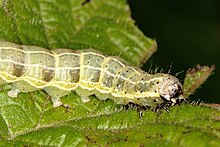Murder caterpillar
As murder crawler are tracked by butterflies (Lepidoptera) indicates that the caterpillars of other species of butterflies as well as other, mainly weichhäutige insects such as aphids eat (Aphididae) as a supplementary food. The expression “insectivore caterpillars” is also used less frequently. The killer caterpillars serve as an admixture to the main vegetable diet. B. the larvae of the Lesser Frostworm ( Operophtera brumata ).
Although the use of terms such as murder and robbery is questionable in the animal kingdom, "murder caterpillar" is used extensively in entomological literature. So far, no suitable attempt has been made to compare the term predator vs. Predator to introduce a linguistically defused term for murder caterpillar .
The terms insectivores or insectivora , which also indicate nutrition by insects, refer to carnivorous plants or to the insectivores from the mammalian order (Mammalia).
Butterflies
Examples of killer caterpillars include the following species of owl butterfly (Noctuidae):
- Trapezoid owl ( Cosmia trapezina ),
- Red-brown elm owl ( Cosmia affinis ),
- White-spotted elm owl ( Cosmia diffinis ),
- Violet-brown elm owl ( Cosmia pyralina ),
- Satellite winter owl ( Eupsilia transversa ),
The caterpillars of many other species attack other caterpillars, especially when there is a lack of moisture under breeding conditions. Occasionally this even leads to cannibalism , ie sibling animals are sucked out themselves.
Is not stored, the digestion of insect larvae in some of the butterflies counting Bläulingsarten (lycaenidae). They are totally dependent on specific species of ants. The common blue ant ( Phengaris arion ) needs the knot ants ( Myrmica sabuleti ) for development. In a symbiotic relationship, the caterpillar feeds itself in exchange for the secretion of a sugary secretion from ant larvae. The same applies to the dark blue ant ( Phengaris nausitous ), which is dependent on the red garden ant ( Myrmica rubra ) as host. Blue ant caterpillars are not referred to as murder caterpillars, as eating ant brood is essential for their natural development cycle.
Individual evidence
- ^ Günter Ebert (Ed.): The butterflies of Baden-Württemberg . 1st edition. tape 6 . Moth IV. Noctuidae 2nd part. Ulmer, Stuttgart (Hohenheim) 1997, ISBN 3-8001-3482-9 .
- ^ A b Arno Bergmann: The large butterflies of Central Germany. Volume 4/2: Owls. Distribution, forms and communities. Urania-Verlag, Jena 1954, DNB 450378381 .
- ↑ Walter Forster , Theodor A. Wohlfahrt : The butterflies of Central Europe. Volume 4: Owls. (Noctuidae). Franckh'sche Verlagshandlung, Stuttgart 1971, ISBN 3-440-03752-5 .
- ↑ Manfred Koch : We identify butterflies. Volume 3: Owls. 2nd, expanded edition. Neumann, Leipzig / Radebeul 1972, DNB 760072930 .
- ↑ Georg Warnecke: Which butterfly is that? Kosmos Naturführer, Franckh'sche Verlagshandlung, Stuttgart 1958.
